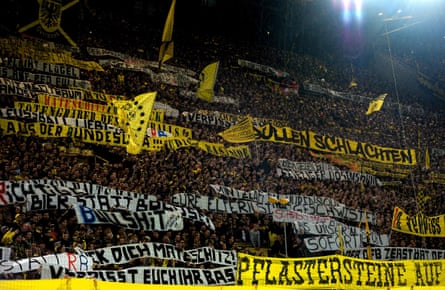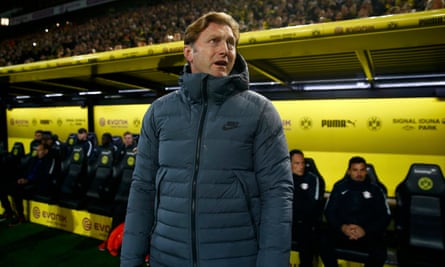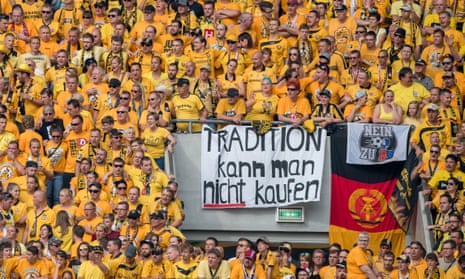Now and again, for one reason or another, a smaller team catches the attention of football fans around the world A couple of years ago it was the number-crunching Danish club FC Midtjylland; this time last year, millions of people around the world were struggling with the correct pronunciation of the high-flying Foxes from Leicester. This season it is RB Leipzig. Their name is slightly easier on the tongue but – like the idea that RB stands for RasenBallSport rather than a sickly Austrian energy drink – it is difficult for many to swallow.
RB Leipzig’s rise through the German leagues and their brief spell at the summit of the Bundesliga in the autumn have not gone unnoticed. And, although there has been almost begrudging admiration and praise for the youthful, attractive and attacking brand of football played under their highly regarded Austrian head coach, Ralph Hasenhüttl, the majority of fans stand on the other side of the fence. RB Leipzig rank among one of the most hated teams in world football.
That hatred was clearly on show last weekend, when RB Leipzig supporters were spat on and pelted with cans and stones by Borussia Dortmund fans. Police filed 28 charges for offences including assault, dangerous bodily injury, damage to property and theft. Four officers and a police dog were injured in the attacks, leaving Borussia Dortmund embarrassed by their own supporters. “Borussia Dortmund deeply regrets that there have been riots on the way of the fans coming from Leipzig,” they said in a statement. “BVB strongly condemns this violence. We wish the injured fans from Leipzig on this way a good improvement.”
The violence last weekend was shocking but RB Leipzig have faced plenty of insults since they were taken over by Red Bull in 2009. One newspaper, the Berliner Kurier, replaced their name with the word Dosenverkauf (can-sellers) when printing the Bundesliga table, and banners reading “slaughter the bulls” have been unfurled at various grounds when Leipzig come to visit. Dynamo Dresden fans took that idea literally last season, when they threw a severed cow’s head towards the pitch from the stands during a cup match with RB Leipzig.

Red Bull had been associated with sport long before RB Leipzig appeared, with a particularly successful presence in Formula One. And, of course, Germany wasn’t the first place to have a Red Bull-owned football club. The company’s co-founder, Dietrich Mateschitz, was the driving force behind the emergence of Red Bull Salzburg in Austria, the New York Red Bulls and Red Bull Brasil, located in São Paulo. Aside from the name, these three clubs have one thing in common: they all previously existed under different names. Put simply, Red Bull scouted out the locations, found a struggling team, took them over, slapped a couple of bulls on the club’s badge, and there you go: a new football team.
In Germany, though, it wasn’t so easy. The company searched for a few years, apparently favouring Hamburg, Munich and Düsseldorf, but their advances to clubs in those cities were rebuffed. Red Bull were pointed in the direction of Leipzig. Their approach was initially knocked back by the German football association (DFB), who wouldn’t allow a club’s name to be changed for advertising purposes, but Red Bull was sold on the prospect of Leipzig – a football city with no Bundesliga club of its own, or even one close by.
To get around the DFB’s rules, they would have to acquire the playing rights of a club outside of its reach – in this case a club in the fifth tier. The club in question was SSV Markranstädt, from a village a few kilometres west of Leipzig. It didn’t take the suits at Red Bull long to do the deal. Just a few weeks after negotiations began, Markranstädt sold its playing rights, leading to the genesis of RasenBallsport Leipzig – the name avoiding any problems with the DFB while still ensuring the club would be commonly known as RB Leipzig. It is fair to say that the birth of Die Bullen was not wildly celebrated and the ill feeling has only grown since.
Nevertheless, fast forward a few years, and Hasenhüttl’s work to date should be admired. The manager may have only been in the job since the team reached the Bundesliga, but he has also climbed up the league structure. After beginning as a youth coach at SpVgg Unterhaching in 2007 in the newly formed 3. Liga, he moved to VfR Aalen, where he took a club that was in danger of dropping into the regional leagues and created an established second division side in less than three seasons. On the back of this success he was appointed head coach at another second division club, FC Ingolstadt. He took them up to the Bundesliga and gave them a mid-table finish in their first ever season in the top flight. Impressive stuff. And in taking RB Leipzig to the top of the Bundesliga last October, he has raised his stock further – so much so that he has already been suggested as a potential successor to Carlo Ancelotti at Bayern Munich or Arsène Wenger at Arsenal.

Despite the corporate nature of the city’s current main representative, Leipzig is steeped in football tradition and can legitimately lay claim to be the home of German football. Not only was the DFB founded in Leipzig in 1900, but the city’s very own VfB Leipzig were crowned league champions in the DFB’s maiden season in 1902-03 (once they had located a ball to play their final match of the campaign) and were also proud occupants of the country’s first large football stadium in 1922.
VfB emerged as one of the country’s top teams in the early years of the 20th century, finishing as champions three times and challenging for the title almost every season. The outbreak of the first world war meant football stood still and the city, and by proxy the club, were heavily affected. Around half of VfB’s club members served in the army and four players from the 1913 championship-winning team lost their lives.
As the country began to rebuild itself after the war, VfB moved into a new ground, the Probstheidaer Stadium, a physical symbol of their place in the nation’s footballing hierarchy. A crowd of 50,000 fans turned out for VfB’s first match at their new ground in August 1922 but, as it turned out, the new stadium said more about where the club had stood before the war than where it would go afterwards. Restoring past glories and reconstructing a team ripped apart by the war proved difficult.
Before the Bundesliga was launched in 1963, football in Germany was played in a very fragmented landscape. VfB Leipzig, along with clubs from Saxony and the other federal states, Saxony-Anhalt and Thuringia, made up the Central German Football Championship, of which VfB Leipzig are the most successful team, with a total of 11 championships. The Nazis’ rise to power, however, led to the creation of the Gauliga system in 1933 whereby Germany’s football clubs were funnelled into 16 (later 18) newly established regions.
The majority of the Gauliga period passed by uneventfully for VfB Leipzig, with the team hovering between midtable and relegation – but 1936 saw a throwback to more successful times. VfB reached the final of the German Cup, then called the Tschammerpokal, where they faced FC Schalke, one of the country’s dominant forces at the time. The 4,000 or so fans who made the journey from Leipzig to Berlin were hopeful that David would overcome the Goliath of the Königsblau and couldn’t believe their eyes when Leipzig brought home the cup after an improbable 2-1 victory.
The Gauliga system lasted only 11 seasons before it was interrupted by the second world war, the fall of the Nazi Party and the subsequent Soviet occupation. Once again, the country’s socio-political landscape had shifted, and sport was swept along by the current of change. Football clubs, as with many organisations in the country, were dissolved by the occupying Allied authorities and the VfB Leipzig of pre-WWII was no more.
The city had to find a new footballing identity but forming a new club was anything other than straightforward as all real or imagined links to the Nazi regime were being cleansed by the Soviet regime. A new club could only include players who were residents of the district where the club was housed, for example. Nevertheless, SG Leipzig-Probstheida, named after the district of Leipzig, rose from the ashes of the war thanks to players and representatives of the now defunct VfB Leipzig and sought to re-enter the country’s footballing pyramid.
Over the next few years the name changed to BSG Erich Zeigner, named after the former Prime Minister of Saxony and prominent anti-Nazi voice, and then BSG Einheit Leipzig Ost, under which name the club won promotion to the DDR Oberliga, the top flight in former East Germany. Shortly after though, Leipzig’s football clubs were once again dissolved and the city’s footballers were filtered into new ones – SC Rotation Leipzig and SC Lokomotive Leipzig. With both of the new clubs playing in the top league in the former east, Leipzig had become a two-club city.
Both teams enjoyed moderate success in terms of league position but it was Lokomotive who won the race to silverware, lifting the East German Cup in 1957. The city’s football identity may have been in a period of near-constant flux, but Leipzig’s fans bought into their new clubs – so much so that a 1956 derby between Lokomotive and Rotation attracted more than 100,000 fans to Leipzig’s vast and deep-set Zentralstadion, still a record in Germany.
But as quickly as the city’s footballing duopoly began to cement it was again interrupted. The level of success was not deemed appropriate for the east’s second biggest city and the creation of a new club, SC Leipzig, was seen as the answer. Although it was supposed to be a combination of Lokomotive and Rotation, the reality was slightly different. The best players from both clubs made up the new team, whereas those who remained were left to form yet another club, BSG Chemie Leipzig. In essence, SC Leipzig had cannibalised the city’s football clubs and cherry-picked the top players, leaving the rest to fend for themselves.
Again, the fans had to choose, and the rivalry formed anew – perhaps this time even more intensely thanks to the sense of injustice followers of BSG Chemie would have been entitled to feel. Nevertheless, despite SC Leipzig reaching the cup final in their first year, it was the best of the rest at BSG who finished the season as champions, suggesting that maybe something went a little awry with the selection process.
Before the dust could settle on another cross-town rivalry, the trigger-happy powers that be introduced new reforms, again with the hope of establishing better parameters for the game to flourish in the east, and again leading to the formation of a fresh club. So it was out with the not-very-old and in with the new – well, kind of. As of 1966 SC Leipzig was no more, replaced by 1. FC Lokomitive Leipzig – the name, as with predecessor SC Lokomotive, coming from the German state railway. Leipzig was, after all, a major hub for German rail, and the 1. FC Lokomotive players were technically employees of the railway.
For many critics of today’s RB Leipzig, the only thing approaching a saving grace is their philosophy of playing young players and advocating fast, dynamic football. This was also the case in the early days of 1. FC Lokomotive, often referred to as FC Lok, thanks to the construction of a new football academy in their district of the city providing them with a conveyor belt of talent, many of whom went on to represent East Germany at international level.
The swinging Sixties saw FC Lok make their first foray into European competition. In 1966 they won the Intertoto Cup, becoming the first club from East German to grab the ears of a European trophy. And despite only making it to the fourth round in the short-lived Inter-Cities Fairs Cup in the same year, Lokomotive turned some heads by knocking outEusébio’s Benfica over two legs the previous round.
Over the next two decades FC Lok began to establish themselves in the Oberliga and form a real identity as a strong cup team, reaching eight finals between 1970 and 1987 – and winning half of them. They became infamous for turning on the style in midweek European matches and then turning in frustratingly inconsistent performances in the league on Saturdays. And this penchant for all things continental led the team to arguably their greatest hour, a place in the 1987 Uefa Cup Winners’ Cup final, where they played an Ajax team managed by Johan Cruyff that featured Frank Rijkaard, Marco van Basten and Dennis Bergkamp. Despite being overwhelming underdogs, FC Lok gave a good account of themselves before ultimately falling to a first-half van Basten header.
Once again socio-political actions superseded sport and, as the Berlin Wall fell and people streamed into the west, the country’s football leagues merged. Aside from Hansa Rostock and Dynamo Dresden, who joined the Bundesliga, teams from the DDR Oberliga were designated a place in the 2. Bundesliga, which was extended to 24 teams to accommodate the newcomers.
Another important decision was made when Leipzig took its place in the new national league: the club reverted back to the name VfB Leipzig – part of the thinking being to revive memories of past glories. Initially it seemed to do the trick as VfB were promoted to the Bundesliga in 1994, but the club came straight back down and bobbed around mid-table for a few seasons before sinking down into the third and fourth tier.
The club went through players and coaches quickly as they tried to retain and later regain their Bundesliga status but it only led to an ever-growing chasm between profit and loss. VfB entered administration in 2000 and, in 2004, just over a century after being crowned Germany’s first ever league champions, VfB Leipzig ceased to exist.
If the previous century had proven anything, it was that Leipzig’s soil is fertile ground for football clubs and new shoots began to emerge quickly. This time it was in the form of a small group of VfB fans, who resurrected 1. FC Lokomotive Leipzig in 2004. The new-look FC Lok absorbed both the women’s team and the youth teams of VfB Leipzig but the first team had to start from scratch, and that meant new trainer Rainer Lisiewicz – himself a former FC Lok player in the 1960s and 1970s – had to put together a completely new team to kick off in the 3. Kreisklasse, at the time the 11th and lowest rung of the footballing ladder.
Despite their lowly status, FC Lok were still able to call the Bruno-Plache-Stadion home and, as the natural heir to VfB Leipzig, they had the supporters to fill it. Of course, a club this size stuck out at that level and the nationwide media attention only enhanced their cult status. Parallels can of course be drawn with AFC Wimbledon and FC United of Manchester in England, and the latter visited for a friendly in 2006.
There was a general groundswell of good feeling for the club but FC Lok has its problems, and not of an insignificant nature. The club has been used as a platform for far-right fan groups to air their political views and although the group has been given an official ban from the stadium, a connection still lingers in the background and has come to the fore against the backdrop of Germany’s debate over refugees.
By 2008 the club had climbed halfway up the ladder to the the fifth tier. It was here, a season later, Leipzig’s newest derby would take place as 1. FC Lokomotive Leipzig came up against RB Leipzig, in the latter’s inaugural season. RB Leipzig won the match comfortably 3-0 and went on to breeze through the division as they bolted their way up the leagues. In that season Leipzig’s clubs (including Sachsen Leipzig, the team RB tried to take over) passed like ships in the night, sailing in different directions.
FC Lokomotive, like so many clubs at their level, are in a constant battle to keep the wolf from the door and must now compete with the emergence of RB Leipzig for hearts, minds and bodies through the turnstiles, but football fans in Leipzig can be grateful the club exists at all.

Comments (…)
Sign in or create your Guardian account to join the discussion